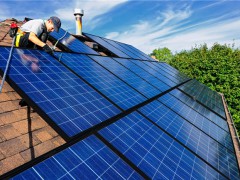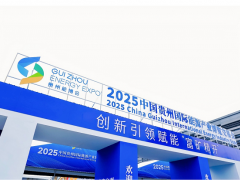新系統(tǒng)模擬光合作用過程,特別是紫色細(xì)菌的有效能量轉(zhuǎn)移
太陽能轉(zhuǎn)化為燃料的效率為15%,這種方法超過自然光合作用,并以令人印象深刻的速度產(chǎn)生甲烷
創(chuàng)新和可持續(xù)的過程利用廉價(jià)的、地球上豐富的元素,潛在地推進(jìn)碳中和的目標(biāo)
據(jù)油價(jià)網(wǎng)2023年8月12日?qǐng)?bào)道,香港城市大學(xué)的一個(gè)研究小組最近開發(fā)了一種穩(wěn)定的人工光催化系統(tǒng),比自然光合作用更有效。新系統(tǒng)模擬天然葉綠體,利用光線將水中的二氧化碳轉(zhuǎn)化為甲烷,后者是一種很有價(jià)值的燃料。這一有希望的發(fā)現(xiàn)可能有助于實(shí)現(xiàn)碳中和的目標(biāo)。
光合作用是指植物和一些生物體內(nèi)的葉綠體利用陽光、水和二氧化碳來產(chǎn)生食物或能量的過程。在過去的幾十年里,許多科學(xué)家試圖開發(fā)人工光合作用過程,將二氧化碳轉(zhuǎn)化為碳中和燃料。
香港城市大學(xué)化學(xué)系副教授葉如泉教授是這項(xiàng)聯(lián)合研究的負(fù)責(zé)人之一,他解釋說:“然而,由于許多光敏劑或催化劑在水中降解,因此很難在水中轉(zhuǎn)換二氧化碳。盡管人工光催化循環(huán)已被證明具有更高的內(nèi)在效率,但在水中減少二氧化碳的低選擇性和穩(wěn)定性阻礙了它們的實(shí)際應(yīng)用。”
香港城市大學(xué)、香港大學(xué)、江蘇大學(xué)和中國科學(xué)院上海有機(jī)化學(xué)研究所的聯(lián)合研究小組在《自然催化》雜志上發(fā)表的最新研究中,克服了這些困難,利用超分子組裝方法創(chuàng)建了一個(gè)人工光合系統(tǒng)。它模仿了紫色細(xì)菌的捕光色素體(即含有色素的細(xì)胞)的結(jié)構(gòu),這種色素體在從太陽轉(zhuǎn)移能量方面非常有效。
新的人工光合系統(tǒng)的核心是一種高度穩(wěn)定的人工納米膠束——一種可以在水中自組裝的聚合物,具有親水和疏水兩端。納米膠束的親水頭部作為光敏劑吸收陽光,其疏水尾部作為自組裝的誘導(dǎo)劑。
當(dāng)它被放入水中時(shí),由于水分子和納米膠束疏水尾部之間的分子間氫鍵,納米膠束會(huì)自組裝。添加鈷催化劑可產(chǎn)生光催化制氫和二氧化碳還原,從而產(chǎn)生氫氣和甲烷。
利用先進(jìn)的成像技術(shù)和超快光譜學(xué),該團(tuán)隊(duì)揭示了創(chuàng)新光敏劑的原子特征。他們發(fā)現(xiàn),納米膠束親水頭部的特殊結(jié)構(gòu),以及水分子與納米膠束疏水尾部之間的氫鍵,使其成為一種穩(wěn)定的、與水相容的人工光敏劑,解決了人工光合作用的傳統(tǒng)不穩(wěn)定性和水不相容問題。光敏劑與鈷催化劑之間的靜電相互作用以及納米膠團(tuán)的強(qiáng)捕光天線效應(yīng)改善了光催化過程。在實(shí)驗(yàn)中,研究小組發(fā)現(xiàn)甲烷的產(chǎn)率超過13000微摩爾每克每小時(shí),24小時(shí)的量子產(chǎn)率為5.6%。它還實(shí)現(xiàn)了高效的太陽能轉(zhuǎn)化為燃料的效率,達(dá)到15%,超過了自然光合作用。
最重要的是,新的人工光催化系統(tǒng)在經(jīng)濟(jì)上是可行的和可持續(xù)的,因?yàn)檫@種新的人工光催化系統(tǒng)不依賴昂貴的貴金屬。葉如泉教授說:“系統(tǒng)的分層自組裝提供了一種有前途的自下而上的策略,可以創(chuàng)建一個(gè)精確控制的高性能人工光催化系統(tǒng),這個(gè)系統(tǒng)基于廉價(jià)的、地球上豐富的元素,如鋅和鈷卟啉復(fù)合物。”
葉如泉教授還表示,他相信這一最新發(fā)現(xiàn)將有利于并啟發(fā)未來利用太陽能進(jìn)行二氧化碳轉(zhuǎn)化和還原的光催化系統(tǒng)的合理設(shè)計(jì),為實(shí)現(xiàn)碳中和的目標(biāo)形成積極助力。
李峻 譯自 油價(jià)網(wǎng)
原文如下:
New Catalyst Paves Way For Green Methane Production
· The new system mimics the photosynthesis process, specifically the efficient energy transfer in purple bacteria.
· With a 15% solar-to-fuel efficiency rate, this method surpasses natural photosynthesis and produces methane at an impressive rate.
· The innovative and sustainable process utilizes cheap, Earth-abundant elements, potentially advancing the goal of carbon neutrality.
A City University of Hong Kong research team recently developed a stable artificial photocatalytic system that is more efficient than natural photosynthesis. The new system mimics a natural chloroplast to convert carbon dioxide in water into methane, a valuable fuel, very efficiently using light. This promising discovery could contribute to the goal of carbon neutrality.
Photosynthesis is the process by which chloroplasts in plants and some organisms use sunlight, water and carbon dioxide to create food or energy. In past decades, many scientists have tried to develop artificial photosynthesis processes to turn carbon dioxide into carbon-neutral fuel.
Professor Ye Ruquan, Associate Professor in the Department of Chemistry at CityU, one of the leaders of the joint study explained, “However, it is difficult to convert carbon dioxide in water because many photosensitizers or catalysts degrade in water. Although artificial photocatalytic cycles have been shown to operate with higher intrinsic efficiency, the low selectivity and stability in water for carbon dioxide reduction have hampered their practical applications.”
In the latest study published in Nature Catalysis, the joint-research team from CityU, The University of Hong Kong (HKU), Jiangsu University and the Shanghai Institute of Organic Chemistry of the Chinese Academy of Sciences overcame these difficulties by using a supramolecular assembly approach to create an artificial photosynthetic system. It mimics the structure of a purple bacteria’s light-harvesting chromatophores (i.e. cells that contain pigment), which are very efficient at transferring energy from the sun.
The core of the new artificial photosynthetic system is a highly stable artificial nanomicelle – a kind of polymer that can self-assemble in water, with both a water-loving (hydrophilic) and a water-fearing (hydrophobic) ends. The nanomicelle’s hydrophilic head functions as a photosensitizer to absorb sunlight, and its hydrophobic tail acts as an inducer for self-assembly.
When it is placed in water, the nanomicelles self-assemble due to intermolecular hydrogen bonding between the water molecules and the tails. Adding a cobalt catalyst results in photocatalytic hydrogen production and carbon dioxide reduction, resulting in the production of hydrogen and methane.
Using advanced imaging techniques and ultrafast spectroscopy, the team unveiled the atomic features of the innovative photosensitizer. They discovered that the special structure of the nanomicelle’s hydrophilic head, along with the hydrogen bonding between water molecules and the nanomicelle’s tail, make it a stable, water-compatible artificial photosensitizer, solving the conventional instability and water-incompatibility problem of artificial photosynthesis. The electrostatic interaction between the photosensitizer and the cobalt catalyst, and the strong light-harvesting antenna effect of the nanomicelle improved the photocatalytic process.In the experiment, the team found that the methane production rate was more than 13,000 μmol h?1 g?1, with a quantum yield of 5.6% over 24 hours. It also achieved a highly efficient solar-to-fuel efficiency rate of 15%, surpassing natural photosynthesis.
Most importantly, the new artificial photocatalytic system is economically viable and sustainable, as it doesn’t rely on expensive precious metals. “The hierarchical self-assembly of the system offers a promising bottom-up strategy to create a precisely controlled, high-performance artificial photocatalytic system based on cheap, Earth-abundant elements, like zinc and cobalt porphyrin complexes,” said Professor Ye.
Professor Ye also commented he believes the latest discovery will benefit and inspire the rational design of future photocatalytic systems for carbon dioxide conversion and reduction using solar energy, contributing to the goal of carbon neutrality.
免責(zé)聲明:本網(wǎng)轉(zhuǎn)載自其它媒體的文章及圖片,目的在于弘揚(yáng)石化精神,傳遞更多石化信息,宣傳國家石化產(chǎn)業(yè)政策,展示國家石化產(chǎn)業(yè)形象,參與國際石化產(chǎn)業(yè)輿論競(jìng)爭(zhēng),提高國際石化產(chǎn)業(yè)話語權(quán),并不代表本網(wǎng)贊同其觀點(diǎn)和對(duì)其真實(shí)性負(fù)責(zé),在此我們謹(jǐn)向原作者和原媒體致以崇高敬意。如果您認(rèn)為本站文章及圖片侵犯了您的版權(quán),請(qǐng)與我們聯(lián)系,我們將第一時(shí)間刪除。







